About Mikania
The Background and the Government Strategy in Controlling Mikania
|
Mikania (Mikania micrantha) is an exotic perennial herbaceous vine belonging to the family Asteraceae (Compositae). It is originated from tropical South and Central America but is now widely distributed in India, Southeast Asia, Pacific islands and South China including Guangdong and Hong Kong.
Similar to the habit of other climbers, Mikania climbs up other plants to reach the canopy for better sunlight. Even worse, its leaves grow vigorously and will cover up other plants eventually causing damage or even killing other plants by cutting out the light for photosynthesis and affecting their growth. Besides, Mikania is known to have allelopathic potential by producing biochemicals that can inhibit seed germination and seedling growth of other plants. Mikania sprawls out rapidly in spring and summer which is the reason for its name “Mile-a-minute Weed”. It reproduces efficiently both sexually by seeds, and vegetatively by rooting at nodes.
Mikania has characteristic opposite, heart-shaped leaves, margins irregularly coarsely toothed, 3 - 13 cm long. Mikania has much branched and hairless to very slightly hairy stems, and numerous small heads of densely clustered white flowers with fragrance. Mikania produces small dried fruits, black in colour, with a terminal tuft of white bristles for wind dispersal.
|
||||||||||||||||
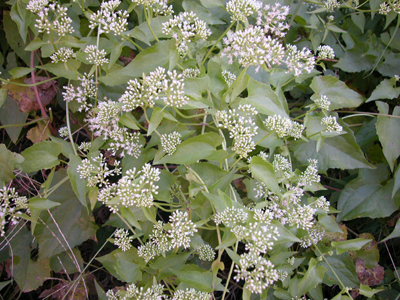 Leaves and flowers of Mikania
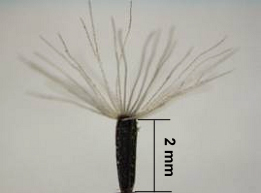 A dried fruit of Mikania with a terminal tuft of white bristles
|
||||||||||||||||
|
|
||||||||||||||||
|
The first record of Mikania in Hong Kong dates back to 1884 but the plant has only become a weed in recent years. It is now usually found in low-lying, moist and disturbed areas with ample sunlight such as derelict fields, abandoned agricultural land, fishpond bund, roadside, disturbed/modified water course and woodland edge around village environs. In Hong Kong, Mikania starts flowering from June and sets fruits from November to February the next year. It produces numerous flowers and a huge amount of seeds with a very high germination rate. These properties are attributable to the high spreading rate of Mikania.
Low temperature and inadequate sunlight can suppress the fruiting, seed germination and growth of Mikania. As such, it does not grow well in shaded environment and therefore has not caused significant adverse impact on established woodland and plantations. However, there have been signs of spreading of Mikania in Hong Kong, especially in the abandoned farmland possibly due to the decline of agricultural activities in recent decades. Moreover, woodland edge, roadside areas and disturbed areas after construction projects are also susceptible to invasion of Mikania. There is growing concern about the potential impact of Mikania to natural vegetation.
|
||||||||||||||||
|
|
||||||||||||||||
|
 Natural vegetation infested with Mikania
|
||||||||||||||||
|
|
||||||||||||||||
|
|
||||||||||||||||
|
Physical control
|
||||||||||||||||
|
Clearing Mikania with physical means (e.g. cleared manually by slashing it with hand tools or mechanically by using a brushcutter) is currently the usual practice in Hong Kong. The stem of Mikania should be cut off as close to the ground as possible and the aerial part should be removed and disposed properly. For those which hang on trees, the aerial part could be cleared up to about 3 metres from the ground while the rest will wither and die off naturally. However, there may be regrowth from the bases and repeated clearing should be applied as and when necessary. Manually pulling out the plants allows removal of roots but could be very labour intensive.
|
||||||||||||||||
|
|
||||||||||||||||
|
Chemical control
|
||||||||||||||||
|
Mikania is susceptible to herbicides such as glyphosate and sulfometuron-methyl. However, application of herbicide is not suitable for sites near water sources, active agricultural lands, gardens and residential areas, and should be used with caution under all circumstances. When the surrounding environment does not permit the use of herbicide, removal of Mikania by physical means should be adopted. Moreover, after the application, Mikania and other vegetation in the treated area would wither altogether which could be unsightly for a period of time. Skilled workers should be engaged for the application of herbicide with all the required safety precautionary measures.
|
||||||||||||||||
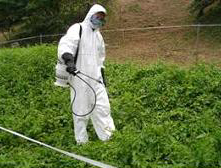 Application of herbicide in progress
|
||||||||||||||||
|
|
||||||||||||||||
|
Habitat management
|
||||||||||||||||
|
A holistic approach in controlling Mikania through habitat management is under trial at certain sites in Hong Kong. As Mikania has a lower germination rate and growth rate in shaded environment, planting trees and shrubs at infested sites after clearance of Mikania could theoretically provide the shaded environment to suppress the weed from regenerating at the sites. Preliminary field observations showed that the regeneration of Mikania at such sites was much reduced after establishment of the plantings. However, intensive maintenance work such as the use of weed mats and frequent weeding was invested in the initial period to control the regeneration of Mikania so as to ensure the healthy growth of the plantings. Considering the resources implication and other site constraints, this approach has only been applied at certain ecologically important sites.
|
||||||||||||||||
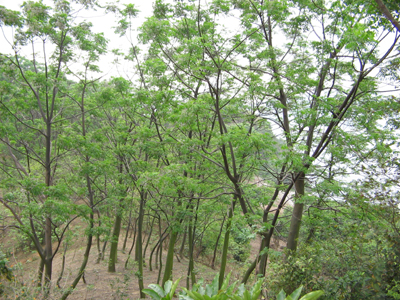 Tree planting has reduced regeneration of Mikania at Centre Island SSSI
|
||||||||||||||||
|
|
||||||||||||||||
|
|
||||||||||||||||
|
Government land
|
||||||||||||||||
|
Various Government departments would carry out vegetation maintenance work as appropriate in accordance with their respective areas of responsibilities. Development Bureau Technical Circular (Works) No. 6/2015 “Maintenance of Vegetation and Hard Landscape Features” sets out the departmental responsibilities for the maintenance of vegetation under different categories of government land. The basic principle adopted is given below:
* Regardless of the land categories, the vegetation on Government SIMAR slopes should be maintained by the slope maintenance department. Departmental responsibilities for the maintenance of SIMAR slopes are given in DEVB TCW No. 6/2011 Maintenance of Man-made Slopes and Emergency Works to Deal with Landslides.
|
||||||||||||||||
|
|
||||||||||||||||
|
Private land
|
||||||||||||||||
|
The government does not have the right to enter private lands to clear Mikania therein. As a matter of principle, owners of private lands should be responsible for maintaining vegetation on their properties and request for clearing Mikania on private land would not be carried out by government departments under normal circumstances.
|
||||||||||||||||
|
|
||||||||||||||||
|
|
||||||||||||||||
|
Confirming the need
|
||||||||||||||||
|
Upon receipt of enquires or complaints on Mikania related issues, a site visit would normally be required to confirm the species of climbing plant of concern and to assess the habitat and vegetation affected. Particular attention should be paid to the climbing plant in question as it could be our native species including common species, such as Climbing Bauhinia (Bauhinia glauca) and Spiny-fruited Vine (Byttneria aspera), and some rare or protected species, such as Hong Kong Mucuna (Mucuna championii) and Illigera (Illigera celebica) which form part of our biodiversity. In such cases, it is not desirable to clear the climbers which would cause unnecessary disturbance to the natural vegetation cover and may even create a niche for Mikania to invade.
|
||||||||||||||||
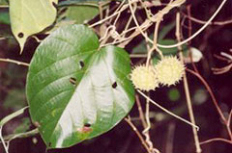 Spiny-fruited Vine (Byttneria aspera)
|
||||||||||||||||
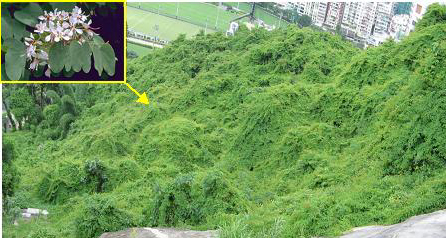 Natural hill slope with Climbing Bauhinia (Bauhinia glauca)
|
||||||||||||||||
|
|
||||||||||||||||
|
Setting the priority
|
||||||||||||||||
|
At the time being, it would be impossible to eradicate Mikania completely in Hong Kong, as it has already taken root in many locations. When considering a request for clearing Mikania, one should firstly assess the priority according to the impacts on vegetation and landuse of the site in question. In general, priority should be given to control the spreading of Mikania at ecologically important areas such as Country Parks, Special Areas and SSSIs and to clear Mikania where mature trees and woodland habitat have been adversely affected. On the contrary, removal of Mikania on derelict fields or disturbed sites may not be justified unless the situation is very unsightly causing public concerns. Site accessibility should also be duly considered as some sites affected by Mikania are on difficult terrains or at remote areas where access would be impracticable.
|
||||||||||||||||
|
|
||||||||||||||||
|
Concerted efforts
|
||||||||||||||||
|
AFCD conducts regular monitoring in Country Parks, Special Areas and SSSIs and would remove Mikania to prevent spreading of this weed in these areas as far as practicable. Other concerned departments would arrange clearing of Mikania affecting the natural vegetation and landscape features in areas under their jurisdictions where warranted. Landowners and management agents of private housing estates should be responsible for the locations within their properties. Various departments or concerned parties may appoint landscape contractors, skilled landscape workers or gardeners to clear Mikania in areas under their jurisdictions. AFCD has also prepared a Practice Note [Eng] / [Chi] on clearing Mikania for interested parties for general reference.
In principle, the best way to protect woodland and trees from damage by Mikania is to monitor the situation with regular maintenance to control its spreading. Depending on the intended landuse of the site in question, planting trees and shrubs at the site may be considered as a long-term measure to control Mikania. In addition, disturbance and fragmentation on natural woodland should be avoided as far as possible in order not to create woodland edges which are susceptible to Mikania invasion.
|
||||||||||||||||